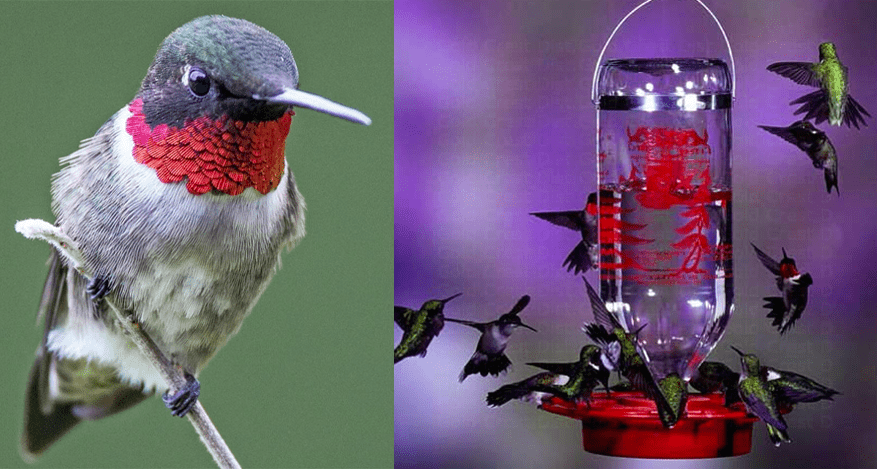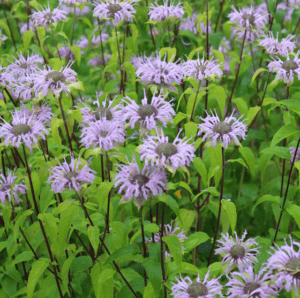
With their shimmering feathers and ability to hover and fly backwards, hummingbirds have always fascinated us. Historically, they have been seen as symbols of love, peace, playfulness, and joy. In nature, they signal the arrival of plants, flowers, insects, and warmer days to come. In Maine, the most commonly seen hummingbird is the Ruby-Throated Hummingbird (Archilochus colubris). Occasionally, however, we may see a Rufous Hummingbird (Selasphorus rufus), or very rarely, a vagrant such as the diminutive Calliope Hummingbird (Selasphorus calliope). Hummingbirds usually arrive in Maine from Central America in early May and typically stay through early October. The males depart first to stake out territory, and the females and juveniles leave about two weeks later.
A Super-Charged Metabolism
 A hummingbird’s heart rate can reach 1200 beats per minute. So, to sustain their incredible metabolism, hummingbirds must eat every 10 to 15 minutes and may visit up to 2,000 flowers a day! In terms of attracting and feeding hummingbirds, there are a variety of approaches. The best, and most natural approach, is through flowers. There are a number of native species that you can plant to attract hummingbirds and other pollinators, including: Wild Bergamot (Monarda fistulosa), Red Columbine (Aquilegia canadensis), Cardinal Flower (Lobelia cardinalis), and Blue Lobelia (Lobelia siphilitica). Hummingbirds are also attracted to feeders. There is a wide variety of types, shapes, and sizes of hummingbird feeders. They can be hung from a pole or mounted to your window for an up-close view.
A hummingbird’s heart rate can reach 1200 beats per minute. So, to sustain their incredible metabolism, hummingbirds must eat every 10 to 15 minutes and may visit up to 2,000 flowers a day! In terms of attracting and feeding hummingbirds, there are a variety of approaches. The best, and most natural approach, is through flowers. There are a number of native species that you can plant to attract hummingbirds and other pollinators, including: Wild Bergamot (Monarda fistulosa), Red Columbine (Aquilegia canadensis), Cardinal Flower (Lobelia cardinalis), and Blue Lobelia (Lobelia siphilitica). Hummingbirds are also attracted to feeders. There is a wide variety of types, shapes, and sizes of hummingbird feeders. They can be hung from a pole or mounted to your window for an up-close view.
What do I feed them?
Flapping your wings up to 2000 times a day can burn a lot of calories. So, we can help them with some supplementary food. A simple recipe is 1 part white cane sugar to 4 parts water. Simply dissolve the sugar in boiling water, and then let it cool before filling the feeder. Another possibility is a premade mixture. However, do not use mixtures with any type of dye or food coloring. Instead, you can use a natural mixture designed for hummingbirds, such as Sweet-Nectarâ„¢. This is a natural nectar concentrate that is dye-free and infused with a proprietary blend of herbal extracts, created from the flowers and fruits most visited by hummingbirds. Just by adding the recommended amount of tap water, one 750 ml bottle of Sweet-Nectarâ„¢ nectar concentrate will make well over a half-gallon of full potency food. It also contains added calcium to promote reproductive and egg health. This product is available in the Maine Audubon Nature Store in ready-to-use and concentrated formulas.
Some Other Helpful Tips
Change the mixture every four to five days; more frequently if temperatures are over 90° F. If the liquid appears cloudy or you see mold, wash the feeder thoroughly right away. Put your feeders at least four feet above the ground so they are beyond the reach of squirrels, who will make a mess of it, or predators such as cats. Also, never place a feeder too close to a nest, because doing so may also cause predation. Feeders should be thoroughly cleaned between refillings – do not “top off” without cleaning. Simply use a mild detergent, such as dish detergent, and rinse thoroughly. Some feeders can even be put in the dishwasher for sterilization. If your feeder is attracting ants, use a moat or ant guard to stop them. Lastly, don’t put your feeders away too soon in the fall. Even though most of the hummingbirds that nested here will be gone by early October, there may still be some lingering passersby for a few weeks that would enjoy “one for the road” to get them to their final destination.
The staff at the Maine Audubon Nature Store will be happy to answer any of your questions regarding hummingbird feeding. Feeders, poles, nectar, and even hummingbird swings are currently available for curbside pick-up. Please give us a call at (207) 781-2330 x201 and we will gladly take care of you.
Our educators, scientists, advocates, and naturalists are committed to keeping you connected to the natural world as we deal with the coronavirus situation together. Check in every weekday on our Connections page for family activities, parent/teacher tips, backyard birding, nature exploration at our sanctuaries, and more.
